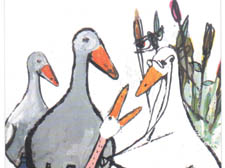|
|
 |
| |
 From Borka, Burningham’s first children’s book, 1963 From Borka, Burningham’s first children’s book, 1963 |
Storyteller of very few words
Children’s illustrator John Burningham’s apprenticeship was creating posters for London Underground, writes Dan Carrier
John Burningham is published by
Jonathan Cape, £25.
POSTER art exploded in the inter-war period.
Prompted by a mix of mass-produced goods to sell, cheap printing techniques being developed, the explosion of eye-catching, modern styles such as Cubism, and techniques such as lino cuts, suddenly art took over the sides of our buses and the platforms of our Tube stations.
It nurtured in a generation of postwar artists the ability to tell a story using very few words and striking images – and one of those artists is the children’s author John Burningham.
The autobiography of Hampstead-based artist John, 74, is published this month and using a lifetime of drawings and story-telling, his book reveals that before he produced his first children’s work, Borka: The Adventures of a Goose with No Feathers, he had worked producing posters for the Underground.
“There is an art to producing publicity posters,” says John. “London Transport had a wonderful history of design, going back to the days of Frank Pick, and I was fortunate to be exposed to this. I was commissioned by Harold Hutchinson, perhaps the last great art editor to work for the Tube.”
He followed a trail already blazed by the likes of Golders Green-based graphic artist Abram Games and Tube map designer Harry Beck. As London Underground sort to carve itself an image in the mind of the public by using art, John had the perfect medium to practise sending a message to viewers using few words and a striking image. When you look at the Tube posters he did before embarking on children’s books, you can see the link immediately.
His posters included images extolling the virtues of day trips to the South Downs, advertising an Underground country walks guide book, days out on the river, taking a water bus to the zoo: all gave him the chance to hone his ability to tell a story in an image. It set him in good stead for writing children’s books.
“With children’s books, everything is pared down to the absolute minimum,” he says. “You have very few words you can use and you have make your story scan from page 1 to page 32. It is a huge problem to make it work like this.”
John’s background was bohemian: he grew up living in a caravan, travelling around remote parts of Gloucestershire and Herefordshire. His education was also mixed. He enrolled at AS Neill’s famous Summerhill school, where pupils were able to choose which lessons they fancied attending.
“Unsurprisingly, I spent a lot of time in the art room,” John recalls.
His mother was an excellent draughtsman and would decorate the letters she sent to boarding school, but it was not until after he had completed his alternative national service that he enrolled at the Central School of Art.
He graduated without a clear idea of how he would use his talent to earn a living, and it was a freelance commission to produce Tube posters that paid his rent. He began working as a professional artist at a time when huge shifts in graphic art were afoot. The timing of John finishing art school, doing his National Service – he was a conscientious objector, so instead of parade grounds he spent his days working for the Forestry Commission and on an organic farm – coincided with the start of the artistic explosion of the early 1960s.
Borka came out in 1963. It was published on a cusp of a graphic revolution: practical changes drove shifts in illustration and book art, and dovetailed with the pop boom.
Advances in printing gave artists the chance to express themselves in ways that were not possible previously.
“There were suddenly greater possibilities with production processes,” John recalls.
Despite his career being helped by such developments, John believes the teaching of art is best served by sticking to tried and tested principles.
“It worries me what students are being taught nowadays at art school,” he said.
“Too many people are simply allowed to fiddle with things on a computer. Students need to go out and draw, attend life classes and master the basics. You need to go through all that to be able to do your own thing.”
• |
 |
|
 |
 |
|
 |
|
 From Borka, Burningham’s first children’s book, 1963
From Borka, Burningham’s first children’s book, 1963
